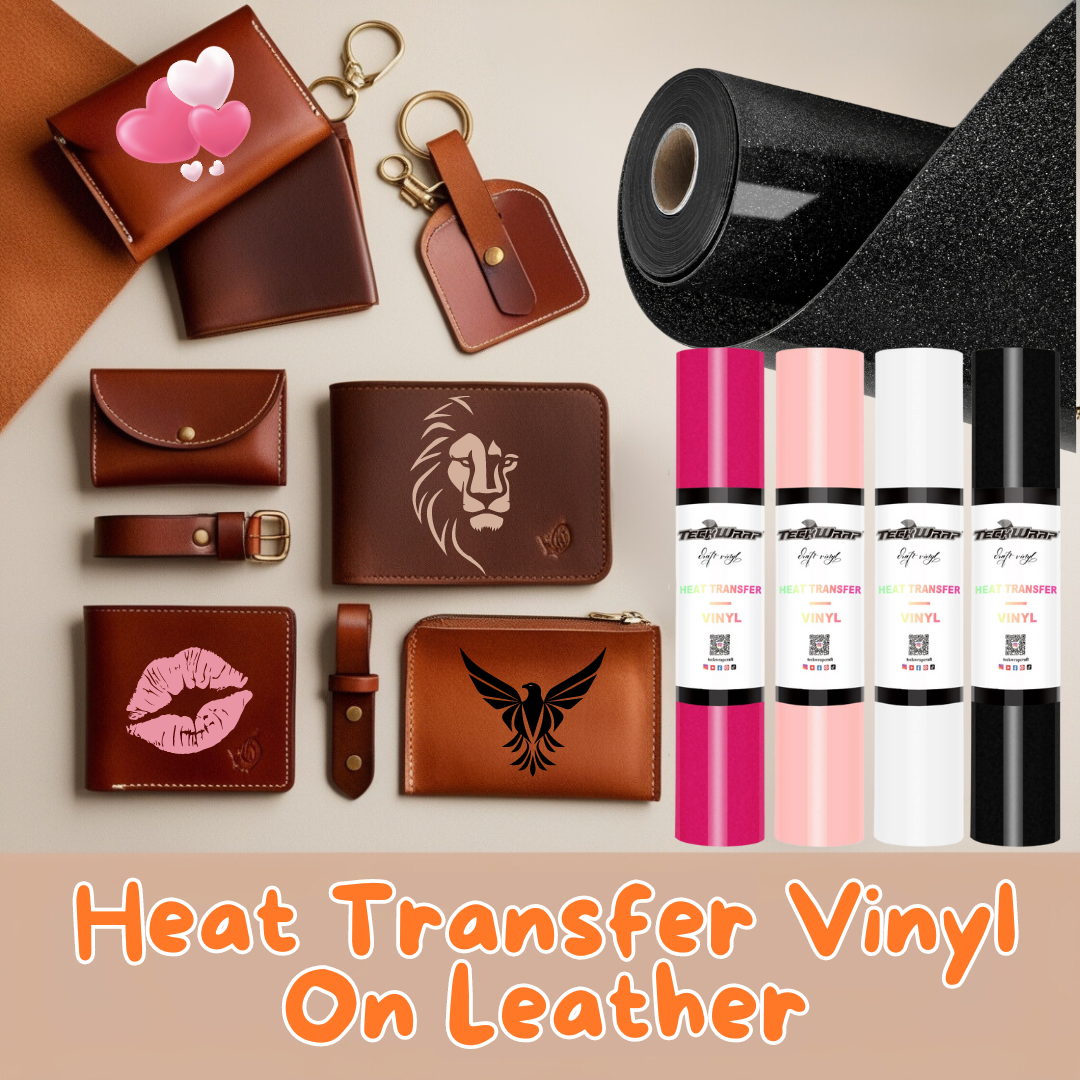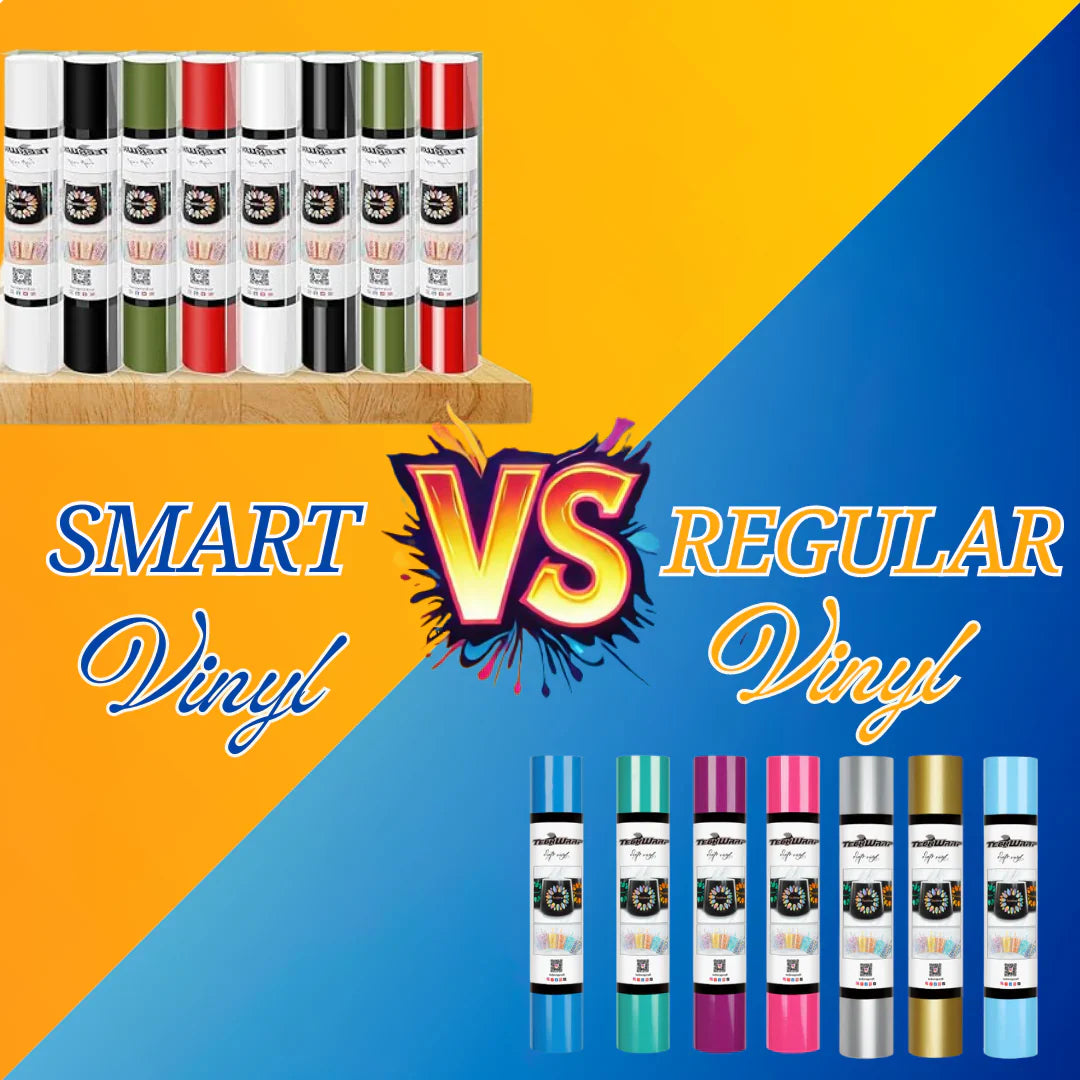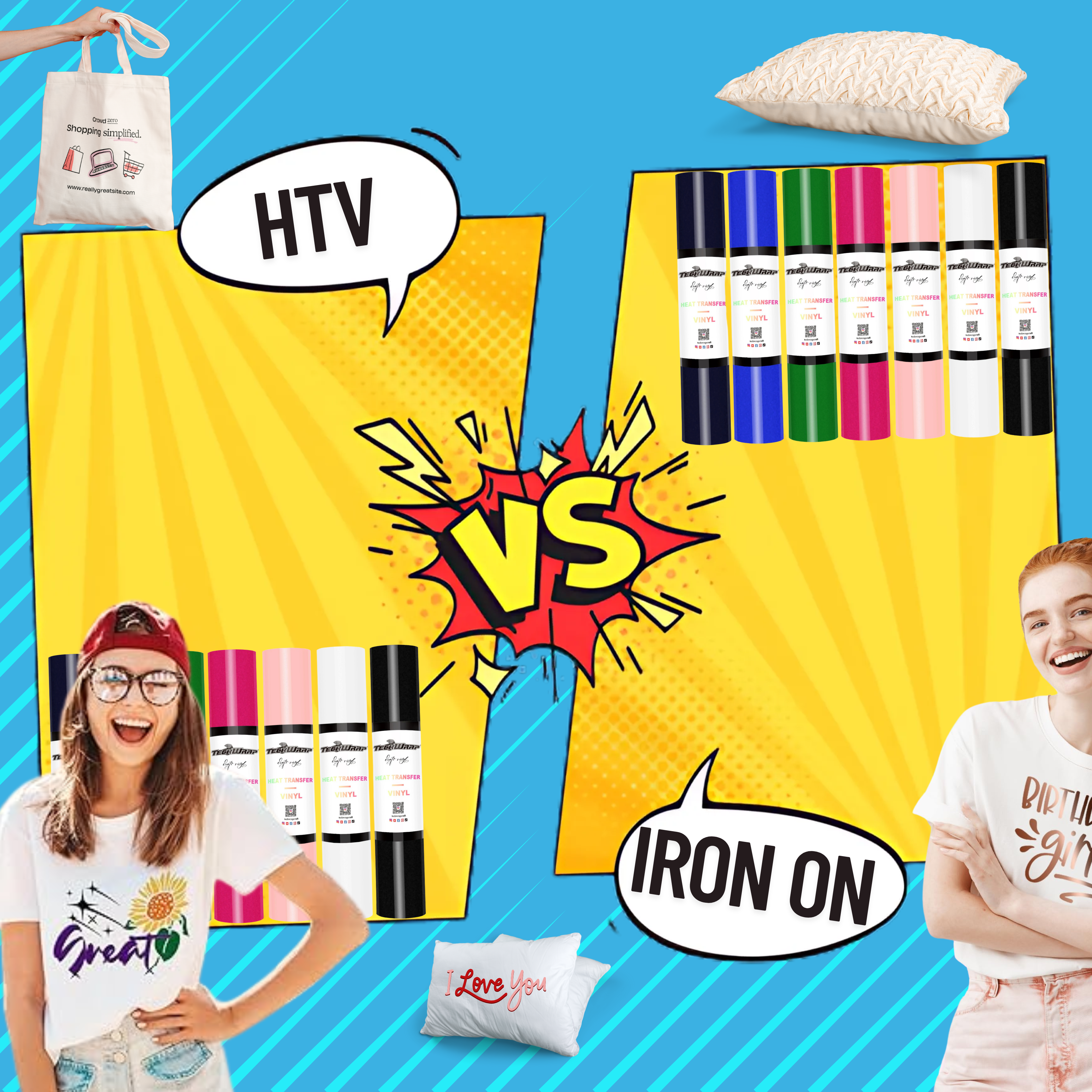Posted By TeckWrap Craft On August 23, 2023
What Can You Use Heat Transfer Vinyl On?

Seeking inspiration to personalize your belongings or create heartfelt, exquisite gifts for your loved ones? TeckWrap Craft brings to you its remarkable heat transfer vinyl! This extraordinary material is crafted to perfection and can primarily be used on different fabrics. It adheres beautifully when heat and pressure are applied to it.
The compatible fabrics that you can use heat transfer vinyl on are cotton, polyester, and poly/cotton blends. You can apply it on different other fabrics as well, but it might not give the same long-lasting performance. You can also use HTV on wood, leather, and other substrates.
If you've ever felt lost amidst the sea of materials, unsure how to bring your creative ideas to life, fear not! We're here to guide you through the ins and outs of using HTV and help you find the perfect materials for your projects.
Whether you're a seasoned pro or a beginner, get ready for an exciting journey as we simplify the process and make your designs stand out! Let's set sail together and unlock the magic of heat transfer vinyl!
What Soft Surfaces To Use Heat Transfer Vinyl On?
Before diving into using HTV on any soft surface, it's crucial to understand that not all fabrics will adhere well to heat transfer vinyl. Each fabric possesses its own unique characteristics that can impact the HTV application process and end results.

100% Cotton
In most cases, HTV works exceptionally well on 100% cotton shirts. It is one of the most commonly used materials for applying this vinyl. Cotton's natural fibers provide an ideal surface for the adhesive to bond effectively, resulting in a smooth and vibrant design.
Cotton is excellent because it can easily bear high heat. The only drawback is that it shrinks when washed, but this issue can be resolved if the cotton shirt or T-shirt on which you are applying the HTV design is pre-washed and pre-pressed before the process.
Cotton have breathable and absorbent nature makes it an ideal material for HTV applications, and the final result is a durable design that resists fading, cracking, and peeling when cared for properly.
Poly/Cotton Blend
Poly/cotton blends, typically composed of 50% cotton and 50% polyester or similar ratios, offer a balance between the softness of cotton and the durability of polyester. By adjusting the heat and pressure settings during HTV application, you can ensure proper adhesion to these blends.
Moreover, a blend of 60% cotton and 40% polyester has gained popularity as a fabric choice for using heat transfer vinyl. The cotton content maintains the softness of the shirt, while the polyester component reduces costs and enhances durability, making it a practical and comfortable option. You might have to reduce the temperature a bit due to the presence of polyester in the blend.
Polyester
Surprisingly, HTV can also be applied to 100% polyester fabrics, though it requires extra attention. Polyester fabrics are sensitive to high heat, so a lower temperature setting is necessary. Additionally, using heat-resistant tape to secure the HTV in place before pressing can prevent scorching or melting of the fabric. Following are some of the tips when working with polyester:
- Ensure that the fabric is 100% polyester and not blended material.
- Polyester does not endure heat as well as cotton. Don’t let it get very hot.
- Instead of exposing it to high temperature, make the duration of heat application slightly longer to work well with polyester.
- If you are using dyed polyester, make sure that the color does not bleed or it will damage the heat transfer vinyl design.
- We recommend using a heat press machine and not a household iron when working with polyester.
Denim
Denim is a versatile cotton fabric, known for its distinctive twill weave with diagonal lines, and is a staple in fashion and casual wear. Symbolizing style and comfort, it appears in jeans, jackets, skirts, and shirts. Available in various washes, finishes, and colors, denim seamlessly combines ruggedness with modern trends. You can easily apply heat transfer vinyl to denim using the same method as cotton, adding unique designs to jeans, jackets, or shorts effortlessly.
Athletic Mesh
HTV isn’t limited to cotton-based fabrics; it can also adhere to athletic mesh and viscose, though durability may vary. Mesh, often made from nylon, polyester, spandex, or lycra, features a breathable, porous structure that allows air and moisture to pass through. When applying HTV to mesh, handle with care to avoid distortion, especially with spandex, which requires stretchable HTV for flexibility. To prevent the adhesive from melting and sticking layers together, place a heat-resistant sheet inside the garment during application.

Viscose
Viscose, also known as rayon, is a type of semi-synthetic fiber derived from cellulose, which is a natural polymer found in plants. Viscose is often considered a bridge between natural fibers like cotton and synthetic fibers like polyester, as it combines properties of both.
It is considered to be a delicate fabric that cannot bear high heat and might get scorch marks. Applying heat transfer vinyl on it might be very tricky and may not give long-lasting performance. You will have to work on very low heat if you want HTV transfer on it.
Leather
Exuding luxury and sophistication, leather has long been a coveted fabric in the fashion industry. And now, with the enchanting touch of HTV, you can infuse your personal uniqueness into this timeless material.
Whether it's genuine or faux leather, HTV effortlessly finds its place, offering endless creative possibilities to elevate your leather fashion to new heights. The only tip is to lower the temperature, increase the application time and apply consistent pressure.
Embrace the fusion of classic elegance and modern customization as you unleash the magic of heat transfer vinyl on leather, making a stylish statement that is uniquely yours.
Canvas
Canvas, with its sturdy, textured surface, is perfect for showcasing intricate designs on items like wall art, tote bags, and cushion covers, making each piece unique with heat transfer vinyl. However, canvas requires a bit more care; use higher pressure and extended pressing time for a strong bond. Place a heat-resistant pillow or mat behind the canvas to provide support and aid adhesion.
While 100% cotton shirts are the simplest for HTV, experimenting with heat and pressure lets you apply it successfully on various fabrics. Knowing each fabric’s qualities helps you turn them into personalized creations with heat transfer vinyl.
On What Hard Surfaces Can You Apply Heat Transfer Vinyl?
The application of HTV isn’t just limited to fabrics, you can in fact apply it to many hard surfaces as well to enliven your decorations. Some common materials include the following:
Glass
You heard it right! Now, you have the power to craft custom crockery and household items with heat transfer vinyl as well. Applying HTV to glassware is easier than you might think. Here are a few tips:
- Start by ensuring the glass surface is clean and free from any grease or dirt. A quick wipe with alcohol will do the trick.
- Place the vinyl design on the glass, positioning it precisely where you want it to be. You can either use a heat gun, especially if it is a curved glass surface, heat press, or mini iron.
- To ensure stability and safety, work on a surface covered with a towel. This will keep the glassware secure during the application process and protect your work area from any excess heat. Also, wear heat-resistant gloves to protect your hands.
- Remember to stay nearby as the glass might get hot during the application. Being vigilant allows you to manage the process smoothly and achieve the best results.
- When working with flat glass, be very careful while applying pressure as you do not want to break it during the process.
With these simple steps, you can elevate your glassware and household items to a whole new level of personalized charm. From custom glasses to decorative vases, let your creativity shine and create stunning designs that will impress and delight everyone.

Wood
Indeed, HTV is incredibly versatile and works wonders on wood as well. It forms a strong bond with most types of wood, creating endless opportunities for unique and personalized creations. However, there are a few essential considerations to ensure the best results when applying HTV to wood:
- Wood Selection: HTV sticks well to various types of wood, making it suitable for a wide range of projects. Whether you're working with plywood, MDF, or solid wood, HTV can beautifully embellish your creations.
- Treated vs. Untreated Wood: While HTV adheres to both treated and untreated wood, treated wood generally yields better results. The treatment process often smooths the wood's surface and helps the adhesive bond more effectively.
- Avoid Glossy Finishes: It's crucial to steer clear of applying vinyl to wood with glossy finishes. The high gloss surfaces can cause the topcoat to burn off during the application process, leading to undesirable outcomes.
By selecting the right type of wood and avoiding glossy finishes, you can ensure successful and stunning HTV applications on wood. Whether you're decorating wooden signs, creating custom home décor pieces, or crafting thoughtful gifts, HTV on wood adds a touch of charm and personalization that will captivate and delight all who behold your artistic creations. So, let HTV unlock the magic of wood for your next crafting adventure!
Ceramics
Ceramics is another fantastic option for applying HTV, but it's essential to keep in mind that it might be a bit less durable compared to other materials like wood or fabric. HTV allows you to transform plain mugs, plates, and other ceramic items into personalized masterpieces.
With a touch of creativity and the magic of heat transfer vinyl, you can add names, quotes, patterns, or intricate designs to elevate your ceramic pieces to a whole new level.
Difference Between Using Heat Transfer Vinyl On Soft And Hard Substrates
Heat-transfer applications do exhibit differences between hard and soft substrates. Fabrics, being stretchable, require extra care when peeling the backing off the printed garment. It's crucial to handle the delicate fabric gently to avoid stretching or distorting the design during this process.
To enhance the adhesion and longevity of the image on soft substrates, re-pressing is often suggested. This involves placing a sheet of parchment paper on top of the finished design and pressing it for 10 seconds after the process is complete and the carrier sheet has been removed. This step ensures that the image becomes firmly ingrained into the fabric fibers.
In contrast, when working with hard surface items, such as ceramic or wood, pressing again is not necessary. The rigidity of these materials allows the HTV to adhere firmly without the need for the final press. Once the application process is complete, the design remains securely attached to the hard surface, requiring no further steps to enhance its durability.
Understanding these distinctions in heat transfer applications allows you to achieve optimal results on various substrates. Whether you're working with soft fabrics or hard materials, the proper handling and techniques ensure your HTV projects stand the test of time, making your creations truly remarkable.

Basics Of How To Apply HTV
Let’s briefly delve into the process and gain a basic understanding of how heat transfer vinyl (HTV) works and the five basic steps involved in applying it:
Heat transfer vinyl works on a simple principle: it features an adhesive on the back that is activated when exposed to heat. This allows it to bond firmly to the surface when pressure is applied during the application process. Now, let's break down the five basic steps of applying HTV:
- Design Creation: Begin by crafting the design you desire using designing software. This is where your ingenuity takes flight, allowing you to conceptualize and create the perfect design for your project.
- Cutting and Weeding: Once your design is ready, it's time to cut it out from the HTV material using a cutting machine. Afterward, comes the weeding process, where you meticulously remove all the excess vinyl around the design, leaving behind the intended artwork.
- Pre-Pressing: Before applying the HTV to your fabric or chosen surface, it's essential to pre-press it. Pre-pressing involves using a heat press machine to briefly apply heat to the fabric. This step ensures any moisture and wrinkles are eliminated, providing a smooth and ideal surface for the HTV to adhere to.
- Application: Carefully place your weeded HTV design onto the prepared surface, ensuring it's aligned correctly. Then, preheat the heat press machine to 310 to 315 degrees Fahrenheit and apply pressure for 10 to 15 seconds. This activates the adhesive, causing it to bond securely with the fabric. Different heat transfer vinyl films might work at varying temperatures. Check the manufacturer’s instructions for the one you are using.
When working with a hard surface, you might have to use a heat gun to make the HTV design bond with the substrate especially if you are applying it to beer glasses or ceramic mugs. - Peeling: Once the application process is complete and the HTV has cooled down slightly, gently peel off the clear carrier sheet from the top of the design. This reveals your masterpiece, with the HTV design now firmly adhered to the fabric.
While these five basic steps form the foundation for creating HTV magic, it's important to understand that each fabric and vinyl combination requires specific heating and pressure levels to achieve optimal results. In our exploration, we'll delve deeper into this crucial aspect, unraveling the secrets to mastering the art of HTV application.
By tailoring the heat and pressure to suit different materials, you'll unlock the true potential of your creations, yielding stunning and professional-looking outcomes. So, let's embark on this journey of discovery, where we learn how to harmonize creativity with precision to bring out the best in every HTV project!
Frequently Asked Questions
Final Thoughts
Unlock your creativity and let your imagination run wild with endless possibilities using our heat transfer vinyl. Embrace uniqueness and make every item truly your own or surprise someone special with a meaningful, customized present. Let the magic of heat transfer vinyl transform ordinary into extraordinary!
Our extensive range of heat transfer vinyl allows you to bring any idea to life with ease. Whether you're working on hard surfaces like wood or soft surfaces like cotton or other fabrics, our HTV is the perfect solution for transferring fabulous designs and adding a highly captivating touch with your personal flair. Buy a few premium quality rolls from TeckWrap Craft, embrace the charm of HTV, and let your imagination soar.








